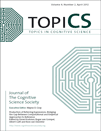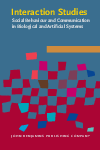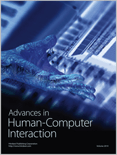
Computers in Human Behavior Reports
Scope & Guideline
Unveiling insights at the crossroads of computers and humanity.
Introduction
Aims and Scopes
- Human-Technology Interaction:
Research on how individuals interact with various forms of technology, including social media, virtual reality, and online learning platforms. This includes the psychological impacts of technology use and its role in shaping social behaviors. - Digital Literacy and Competence:
Exploration of the skills required to effectively navigate and utilize digital tools. This includes studies on digital literacy in educational settings, workplace environments, and among different age groups. - Mental Health and Well-being:
Investigations into the effects of technology on mental health, including studies on social media's impact on anxiety, depression, and overall well-being. The journal also addresses interventions using technology for mental health support. - Educational Technology:
Focus on the use of technology in educational settings, including the effectiveness of online learning, blended learning environments, and the development of digital competencies among students and educators. - Technostress and Digital Overload:
Research on the negative consequences of technology use, such as technostress, digital fatigue, and the implications for work-life balance and productivity. - User Experience and Interaction Design:
Studies that analyze user experiences with technology, including the design of user interfaces, accessibility, and the emotional responses elicited by digital tools.
Trending and Emerging
- Impact of Artificial Intelligence:
A growing focus on how AI technologies influence user behavior, decision-making, and emotional responses, particularly in educational and workplace settings. - Metaverse and Virtual Environments:
Increasing research on user engagement, social dynamics, and psychological effects within the metaverse and other virtual environments, reflecting the rise of immersive digital experiences. - Digital Well-being and Mindfulness:
An emerging emphasis on promoting mental health through digital interventions, including mindfulness apps and online support communities, highlighting technology's role in enhancing well-being. - Technostress Management:
As technostress becomes more prevalent, studies exploring strategies and interventions to manage digital overload and stress are gaining traction, reflecting a need for coping mechanisms in a technology-driven world. - Diversity and Inclusivity in Technology Use:
Research addressing how different demographic factors (e.g., age, gender, cultural background) impact technology use and experiences, emphasizing the need for inclusive design and understanding diverse user needs.
Declining or Waning
- Traditional Media Influence:
Research focusing on the effects of traditional media (television, radio, print) on behavior is becoming less prominent as digital media and social networking sites take center stage in studies about behavior and interaction. - General Internet Use and Addiction:
While internet addiction was a significant focus in earlier publications, recent papers have shifted towards more specific aspects of technology use, such as social media addiction or smartphone dependency, indicating a more nuanced approach to the topic. - Face-to-Face Communication Studies:
As technology-mediated communication becomes more prevalent, studies specifically focused on traditional face-to-face interactions are declining, with less emphasis on how these interactions compare to digital communication. - Crisis Response and Technology:
Research examining the role of technology in crisis management and response during events like natural disasters or economic crises has waned, possibly due to the saturation of studies in this area. - General Psychological Effects of Technology:
Broader studies on technology's psychological effects are being replaced by more targeted research focusing on specific populations or technologies, such as the impact of AI on specific user groups.
Similar Journals

BEHAVIOUR & INFORMATION TECHNOLOGY
Pioneering Research at the Crossroads of Behavior and Tech.BEHAVIOUR & INFORMATION TECHNOLOGY, published by Taylor & Francis Ltd, is a leading journal in the interdisciplinary field that bridges the gap between technology and human behavior. Established in 1982 and continuing through 2024, this journal has garnered a high reputation with impressive rankings in 2023 across various categories: Q1 in Arts and Humanities (miscellaneous), Q2 in Developmental and Educational Psychology, Q2 in Human-Computer Interaction, and Q1 in Social Sciences (miscellaneous). The journal's robust Scopus rankings point to its influence among peers, being placed in the top percentiles across multiple relevant disciplines. Although it does not offer open access, it remains a pivotal resource for researchers and practitioners interested in the dynamics of technology's impact on behavior. By publishing rigorously peer-reviewed research, BEHAVIOUR & INFORMATION TECHNOLOGY aims to foster insights that enhance our understanding of how information technology shapes human interactions and societal outcomes, making it a crucial publication for anyone engaged in this rapidly evolving field.

Topics in Cognitive Science
Innovating Insights into Human Thought and BehaviorTopics in Cognitive Science, published by WILEY, is a premier interdisciplinary journal that advances the understanding of the cognitive processes that underpin human behavior and interaction with technology. With a commendable impact factor and a strong focus on research from 2009 to 2024, this journal garners significant attention in various subfields, as evidenced by its Q1 ranking in Experimental and Cognitive Psychology and Linguistics and Language, alongside a Q2 position in Artificial Intelligence, Cognitive Neuroscience, and Human-Computer Interaction. Researchers and professionals will find invaluable insights into the latest experimental findings, theoretical discussions, and practical applications that bridge cognitive neuroscience, psychology, and computer science. Topics in Cognitive Science is especially pivotal for those aiming to delve deeper into cognitive mechanisms and their implications within our increasingly digital world, making it an essential resource for students and scholars alike.

Interaction Studies
Navigating the Intersections of Language and TechnologyInteraction Studies is a premier journal published by JOHN BENJAMINS PUBLISHING CO, focusing on the dynamic intersections between language, communication, and technological interaction. Since its inception in 2004, the journal has established itself as a critical resource in the fields of Animal Science and Zoology, Communication, Human-Computer Interaction, and Linguistics and Language, achieving impressive rankings and quartile placements across multiple disciplines. The journal's commitment to interdisciplinary research is reflected in its Q1 status in Linguistics and Language and Q2 rankings in both Communication and Animal Science for 2023. Interaction Studies not only provides a platform for innovative research but also facilitates a deeper understanding of complex interactions in various contexts, making it an essential read for scholars, professionals, and students alike. The journal is based in the Netherlands and is accessible through traditional subscription models, with an extensive archive providing valuable insights into evolving scholarly discourses. With its robust impact and academic rigor, Interaction Studies is poised to remain a leading voice in the ongoing exploration of interactive phenomena.

Cognition Technology & Work
Advancing Understanding of Cognition in the WorkplaceCognition Technology & Work, published by SPRINGER LONDON LTD, is a premier journal dedicated to exploring the multifaceted interactions between cognitive processes and technological applications in various work environments. With an ISSN of 1435-5558 and an E-ISSN of 1435-5566, this journal has established itself as a critical resource for scholars and practitioners in the fields of Computer Science, Human-Computer Interaction, and Philosophy. Evaluated in the 2023 Journal Citation Reports, it holds impressive category quartiles, ranking Q2 in Computer Science Applications and Human-Computer Interaction, and Q1 in Philosophy, highlighting its significant impact in academic discourse. Furthermore, its Scopus rankings showcase its robust standing, particularly within the Arts and Humanities and Computer Science sectors. Adopting a rigorous peer-review process, the journal aims to foster scholarly communication and advancement in the understanding of cognitive influences on technology in the workplace. It serves as an essential platform for researchers, professionals, and students alike, providing insight into innovative methodologies and theoretical frameworks that shape the future of cognitive technology in work settings.

Pacific Asia Journal of the Association for Information Systems
Unveiling Insights for the Future of Management Information SystemsPacific Asia Journal of the Association for Information Systems (ISSN: 1943-7536, E-ISSN: 1943-7544) is a leading academic journal published by the Association for Information Systems, based in the United States. With a focus on cutting-edge research in Information Systems, Human-Computer Interaction, and Management Information Systems, this journal is vital for researchers, practitioners, and students who seek to explore the complexities and innovations in these fields. It boasts notable Scopus rankings, including a Q2 classification in Information Systems and Management, indicating its pivotal role in driving scholarly dialogue and advancing knowledge within the discipline. The journal offers rich insights into both theoretical and practical aspects, fostering collaboration and discovery among its readership. Recognizing the importance of Open Access in promoting knowledge dissemination, the journal continues to strive towards making impactful research accessible to a wider audience. With a commitment to excellence and thought leadership, the Pacific Asia Journal is an invaluable resource for anyone engaged in the evolution of information systems.

Educar
Fostering Dialogue Between Academia and PracticeEducar, published by the Universitat Autònoma de Barcelona, stands as a significant contributor to the fields of education, communication, and human-computer interaction. With an Open Access policy since 1982, this journal provides an invaluable platform for the dissemination of innovative research and insightful perspectives from diverse academic backgrounds. The journal boasts a commendable position in the 2023 category quartiles, ranking Q2 in Communication and Q3 in both Education and Human-Computer Interaction, which underscores its relevance and influence within these disciplines. Educar is indexed in Scopus and reflects a strong reception in the academic community, with its Social Sciences - Communication category ranked 173rd out of 511 journals, affirming its 66th percentile standing. Researchers and professionals will find this journal particularly useful for accessing a wide range of studies that not only push the boundaries of knowledge but also offer practical insights that enhance educational practices and technological engagement.

Human Behavior and Emerging Technologies
Unveiling the Future of Human Interaction with Emerging TechHuman Behavior and Emerging Technologies is a pioneering open-access journal published by Wiley-Hindawi, dedicated to advancing the understanding of the intersection between human behavior and technological innovation. With an E-ISSN of 2578-1863, this journal has quickly established itself as a leading platform for disseminating research from 2019 to 2024 and proudly holds a prestigious Q1 ranking in Human-Computer Interaction, Social Psychology, and Social Sciences (miscellaneous) as of 2023. Its exceptional Scopus rankings place it in the top 1% of journals in the fields of general social sciences, social psychology, and human-computer interaction, underlining its significance in an increasingly technology-driven world. The journal aims to foster interdisciplinary collaboration and explore novel approaches to human behavior, offering insights that appeal to researchers, practitioners, and students alike. As an open-access publication, it enhances accessibility to fundamental research findings that inform policy-making, technological development, and social practices in an era characterized by rapid technological advancement.

Internet Research
Decoding the Internet's Influence on Society and EconomyInternet Research, published by Emerald Group Publishing Ltd, stands as a pivotal peer-reviewed journal in the domains of communication, economics, and sociology. Established in 1991, it has continually advanced the understanding of how the internet influences human interaction, economic behaviors, and sociopolitical structures. With impressive ranking achievements, including Q1 status in Communication, Economics and Econometrics, and Sociology and Political Science, the journal is recognized for its high impact, evidenced by its outstanding Scopus rankings—28th in Sociology and Political Science and 12th in Communication, highlighting its relevance and quality within the academic community. While the journal is not open access, its selective publication of landmark research attracts a dedicated readership of scholars, professionals, and students eager to explore the multidimensional impacts of the digital age. With a focus on innovative methodologies and empirical findings, Internet Research aims to foster scholarly discourse that shapes our understanding of the evolving online landscape through 2024 and beyond.

Advances in Human-Computer Interaction
Innovating the way we connect with machines.Advances in Human-Computer Interaction is a premier peer-reviewed journal published by HINDAWI LTD, dedicated to the exploration of cutting-edge research and innovation in the field of Human-Computer Interaction (HCI). With an ISSN of 1687-5893 and an E-ISSN of 1687-5907, this Open Access journal has been contributing to the scientific community since 2008, offering unrestricted access to critical findings and advancements. Based in Egypt with an address at ADAM HOUSE, 3RD FLR, 1 FITZROY SQ, LONDON W1T 5HF, ENGLAND, it occupies a notable position in the academic landscape, reflected in its 2023 Scopus ranking of Rank #57/145 and a 61st percentile in the Human-Computer Interaction category. As a Q3 journal, it plays a crucial role in disseminating research that bridges the gap between humans and technology, providing valuable insights for researchers, professionals, and students pursuing expertise in this dynamic field. The journal’s converged years from 2010 to 2024 signify its ongoing commitment to advancing knowledge and fostering collaboration among HCI experts worldwide.

Multimodal Technologies and Interaction
Unlocking the Potential of Multimodal Systems.Multimodal Technologies and Interaction, published by MDPI since 2017, is an esteemed open-access journal based in Switzerland, dedicated to the exploration and advancement of innovative multimodal systems that enhance user experience across various digital platforms. With its commitment to disseminating high-quality research in diverse areas such as Computer Networks and Communications, Human-Computer Interaction, and Neuroscience, the journal has rapidly established itself within the academic community, achieving a commendable position in Scopus rankings including Q2 in both Computer Networks and Communications and Computer Science Applications. As an essential resource for researchers, professionals, and students alike, Multimodal Technologies and Interaction fosters interdisciplinary dialogue and supports the development of cutting-edge technologies, ensuring that advancements in multimodal interaction are accessible to a global audience. Scholars can benefit from its Open Access format, allowing unrestricted access to influential studies that shape the future of technology and interaction design.